In 1998, Terrence Malick made a remarkable film called The Thin Red Line. A film that examines the nature of man in relation to the world that surrounds him. The Thin Red Line is a war film taking place during the Battle of Guadacanal in World War II, it follows C Company during the eventual victory of the Allied Troops. It’s interesting because the outcome of the battle isn’t very important to the film. Malick doesn’t concern himself with politics and whether or not the war was justified, he’s more interested in the nature of man in context of war. How do we fit in with the world?
Opening the film is a strange and tranquil 15 minute introduction with Private Witt (James Caviezel), he has gone AWOL and is living with Melanesian native in the South Pacific. These early scenes are extremely peaceful, with a group of people that have no concept of violence against each other. They live as a community and seem to have taken Private Witt as one of their own. He is later found and taken back by the Army by First Sergeant Welsh (Sean Penn). This is strange because Private Witt is not the main character, he is one of the characters we follow through the film. Malick takes this convention of introducing the film by throwing out the relevance and trope of the conventional protagonist. Interestingly enough, the film follows the arcs of many.
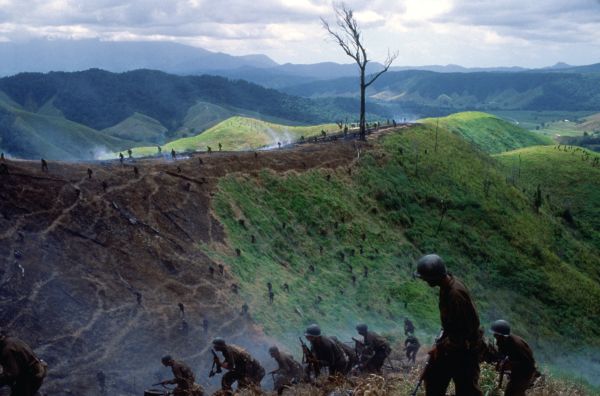
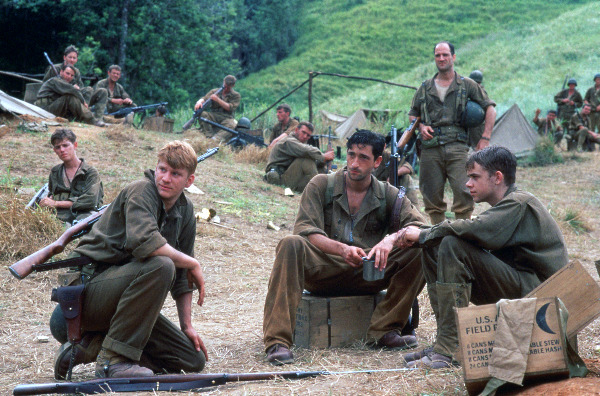
The casting of The Thin Red Line is also peculiar because of the celebrity that goes along with it. From John Travolta to Nick Nolte, Woody Harrelson, John Cusack, John C. Reilly, Nick Stahl, Jared Leto, Sean Penn, Adrian Brody and George Clooney (among others) are cast in this film. Was it to bank of their collective celebrity at the box office? Were big named stars looking to work with a great filmmaker like Terrence Malick? Or is Malick trying to say something through the casting? I would say it’s a comment on the randomness of violence. The idea of how nature is cruel is brought up again and again in this film. As a member of the audience, we are conditioned to think that if a big named celebrity (like the ones in this film) are in a movie then there’s no possible way they’ll be killed, especially early on. Malick (and war) are not afraid to kill a star during a battle sequence. This take on casting was used in 2008’s The Hurt Locker when Kathrine Bigelow cast Guy Pearce only to be killed in the first 10 minutes of that movie. What these filmmakers are trying to say is that war is an unforgiving act, no one is safe from its harm, even in Hollywood movies.
Rest to sure, that The Thin Red Line is a Hollywood film but it’s one of the strange instances where typical Hollywood fare transcends into high art (Yes, sometimes it’s possible). The film was nominated in 1999 for seven Academy Awards including Best Picture, Best Director, Best Cinematography, Best Adapted Screenplay, Best Score, Best Sound and Best Film Editing but not winning any of these awards. It lost out to other Oscar Nominated films in 1999 like John Madden’s Shakespeare In Love (Best Picture) and Steven Spielberg’s Saving Private Ryan (Another film about World War II for Best Director). Not to say this film didn’t get any critical recognition in 1999, it made many film critics and publications top ten list for 1999 including winning the Golden Bear Award at the Berlin Film Festival.
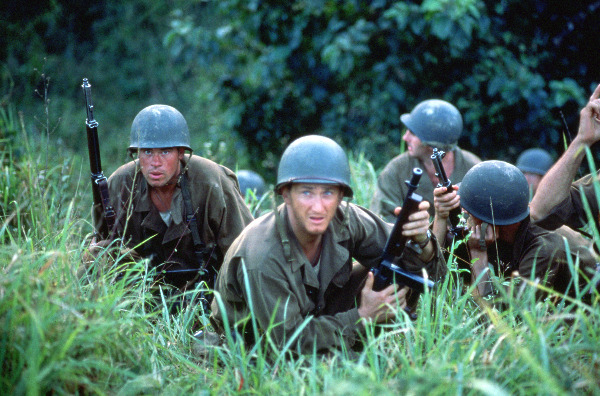
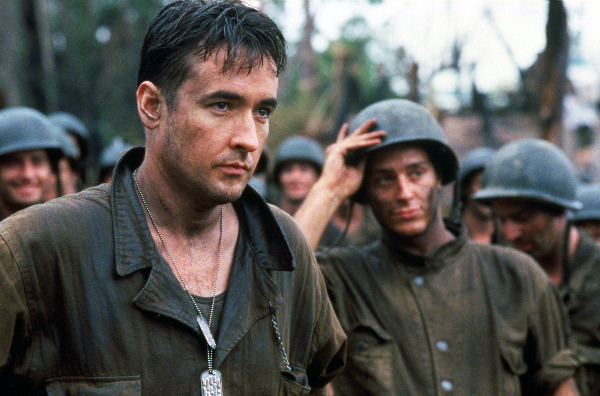
The release from Criterion is absolutely exquisite with a new digital transfer approved by Terrence Malick and cinematographer John Toll, the images are breathtaking, sweeping and so rich in color and texture. A new commentary recorded in 2010 features John Toll, production designer Jack Fisk and producer Grant Hill. The bonus features on the second disc will be a treat for any Terrence Malick fan which include interviews from the casting sessions, editors and producers on The Thin Red Line. Interestingly, you get a kick out of the casting sessions, casting director and audition tapes. Dianne Crittenden, the casting director, and Terrence Malick auditioned practically every male actor from ages 18 to 56 in Hollywood for the astounding 165 speaking roles from the script of The Thin Red Line. I found these audition tapes to be most fascinating, thinking about the hundreds of different ways this film could have been cast.
The way The Thin Red Line was put together was absolutely staggering. Three different editors were brought on to put together different sections of this humongous film. And really, it does make sense, this film at times is a thrilling war epic with the battle scenes to back it up and also a reflective, introspective meditation on the existence of man and his relation to nature and violence. At times it does feel like two different films but tonally it feels like a modern masterpiece.
Grade: A+
The Thin Red Line is now available on Blu-ray and DVD from The Criterion Collection.


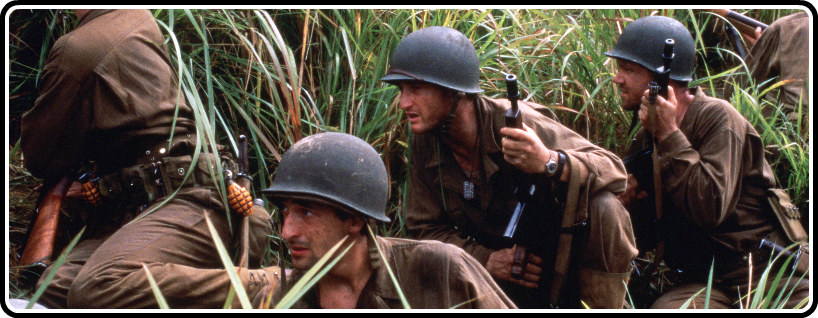
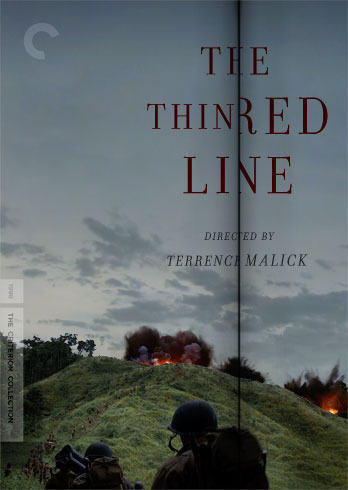
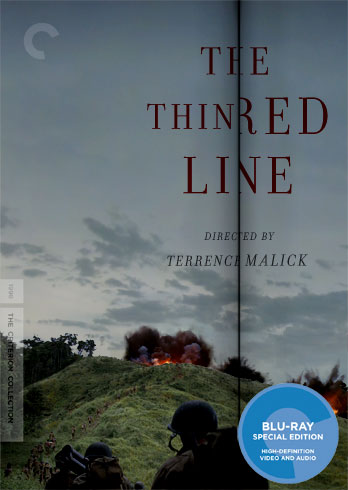



![Bergman Island (The Criterion Collection) [Blu-ray]](https://criterioncast.com/wp-content/uploads/2022/11/bergman-island-the-criterion-collection-blu-ray-400x496.jpg)
![This Is Not a Burial, It’s a Resurrection (The Criterion Collection) [Blu-ray]](https://criterioncast.com/wp-content/uploads/2022/11/this-is-not-a-burial-its-a-resurrection-the-criterion-collection-blu-ray-400x496.jpg)
![Lars von Trier's Europe Trilogy (The Criterion Collection) [The Element of Crime/Epidemic/Europa] [Blu-ray]](https://criterioncast.com/wp-content/uploads/2022/11/lars-von-triers-europe-trilogy-the-criterion-collection-the-element-of-400x496.jpg)
![Imitation of Life (The Criterion Collection) [Blu-ray]](https://criterioncast.com/wp-content/uploads/2022/11/imitation-of-life-the-criterion-collection-blu-ray-400x496.jpg)
![The Adventures of Baron Munchausen (The Criterion Collection) [4K UHD]](https://criterioncast.com/wp-content/uploads/2022/11/the-adventures-of-baron-munchausen-the-criterion-collection-4k-uhd-400x496.jpg)
![Cooley High [Criterion Collection] [Blu-ray] [1975]](https://criterioncast.com/wp-content/uploads/2022/11/cooley-high-criterion-collection-blu-ray-1975-400x496.jpg)
This will be the first disc I buy once I get my head out of my ass and buy a Blu-Ray player.
Seeing this film again, in this way, is just what the film doctor ordered. It’s gorgeous, the sound is amazing and it’s a film that sits in the shadow of Spielberg’s overblown Saving Private Ryan. Malick’s is much better and I wish more people had seen it.
THIS IS THE MOST STUNNING WAR – FILM THAT I HAVE EVER SEEN !
THE INTROSPECTION OF MANS’ ACTIONS AND REACTIONS WAS REALLY
THOUGHT – PROVOKING. THE FUTILITY OF WAR KEENLY OBSERVED..
EVERYONE, AND I MEAN EVERYONE SHOULD SEE THIS BEAUTIFUL FILM